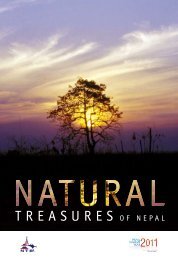treasures of nepal
treasures of nepal
treasures of nepal
- No tags were found...
You also want an ePaper? Increase the reach of your titles
YUMPU automatically turns print PDFs into web optimized ePapers that Google loves.
at Thakurdwara in Bardiya National Park and TheMustang Eco-Museum at Jomsom in Mustang.These days, private collectors have also beenencouraged to stage exhibitions to display theircollections <strong>of</strong> different types <strong>of</strong> traditional artsand handicraft items.At Lumbini, the birthplace <strong>of</strong> Lord Buddha, thereis the all important archaeological remains <strong>of</strong>the Maya Devi Temple, especially the alcoveremains which date from 3rd century B.C. Thearchaeological ruins <strong>of</strong> monasteries date from3rd century B.C to 5th century A.D. Numerousartefact items were discovered while excavatingthe Lumbini area, such as silver coins, child’stoy and a ram made <strong>of</strong> clay on wheels which wasprobably used during early period. The BuddhistInternational Research Library at Lumbini has arich collection <strong>of</strong> Buddhist texts.Nepal’s museums have rich collections<strong>of</strong> archaeological, historical and artisticimportance. Besides the archaeological objectsdating from the time <strong>of</strong> Lord Buddha unearthedat Lumbini, Tilaurakot and other places inwest Nepal, pre-historic archaeological objectsdiscovered in the Mustang caves belong to 8thcentury B.C. Stone statues, inscriptions, coinsand many other archaeological objects have beendiscovered in the Kathmandu Valley which datesfrom the 1st century. As Nepalese are icon (idol)worshipers, a vast treasure <strong>of</strong> cultural wealth inthe form <strong>of</strong> stone, wood and metal sculpturesand religious paintings remain in privatepossession with private collectors.Traditional HandicraftsNepalese handicrafts have been popular sincelong. The mention <strong>of</strong> the woolen blanket in the‘Kautilya Artha Sastra’ <strong>of</strong> Chanakya Bishnu Gupta(Kautilya) which dates back to 4th century B.C.proves this fact. Nepalese bronze artefacts havebeen treasured by the Tibetans since the time<strong>of</strong> the Lichchhavis (3rd and 4th century A.D.).During the medieval period, Nepalese handicraftswere very popular in China and India. Sculpturedornaments and religious idols and statuettesin gold, silver, bronze, brass, stone and woodand embossed with semi-precious stones werehighly sought-after merchandise in China andIndia. Chinese travellers appreciated the skilland craftsmanship <strong>of</strong> the Nepalese artisans,especially their weaving, spinning, wood carvingand metal work. The contribution <strong>of</strong> the mastercraftsman, Arniko, who enriched Nepalesehandicrafts and popularised them throughoutTibet, China and other countries <strong>of</strong> the FarEast was immense. Nepalese handicrafts aredeeply rooted in the socio-religious and culturallives <strong>of</strong> the people. They can be divided intotwo main categories: articles <strong>of</strong> daily use andartefacts/articles <strong>of</strong> aesthetic value and religioussignificance. These range from artefacts linked toritualistic cults during the worship <strong>of</strong> deities toobjects used in daily life, like pots and hairpinsto hookahs (hubble-bubble), beads, shawls andskirts. Ethnic craftsmen have demonstrated theirdistinct characteristics in the design, modellingand production process <strong>of</strong> the artefacts. Theethnic utilitarian handicrafts constitute a longrange <strong>of</strong> articles, like khal-lohara (pestle andmortar), amkhora (waterpot), anti (winejar), sukunda(oil lamp), karuwa(water jar), thaal(plate), kachaura(saucer), kasaudi(cooking pot), chulesi(vegetable cutter),gagri (water pitcher),khukuri (gorkha knife) anddhakki (basket).Nepal’s handicraftindustry <strong>of</strong> todayis almost totallydependent on tourism48




